Contents:
- General rules for the care of glass-ceramic
- What can I use to clean the plate?
- What is the most effective chemistry?
- How to remove lime scale?
- The most persistent pollution
- How difficult is it to care for glass ceramics?
Care of the surface of the ceramic glass hob is an easy task if you wipe it after every meal. But how to clean the glass-ceramic plate from burnt fat and dried stains, so as not to scratch and damage the surface?
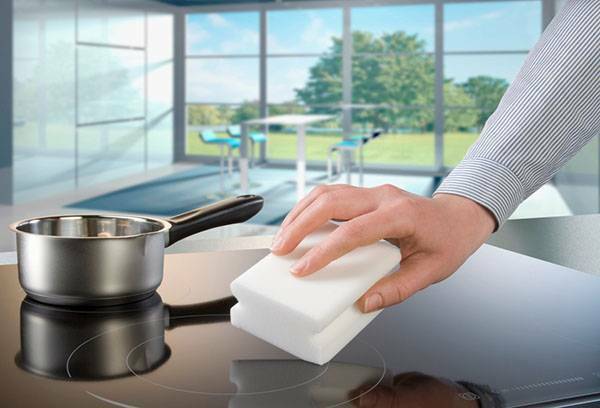
General rules for the care of glass ceramics
Electric cookers with a surface of glass ceramics are very convenient, but in the care of them there are some nuances. It is possible to wash the hob only after cooling, that is after all the remaining heat indicators go out. An exception is if a syrup or jam is spilled onto the stove. In this case, you need to immediately clean the contamination with a scraper, but the sponges can be wiped only after cooling.
Another feature - not all the appliances that the housewives are cleaning for persistent dirt are suitable for cleaning. Do not use the following tools:
- metal brushes and scouring pads;
- coarse abrasive substances;
- strongly acidic cleaning chemicals.
Advice
Plastic wipes do not leave visible scratches, but after them remain microdamages. After regular use, the appearance of the plate deteriorates, and the dirt accumulates more and more, so use them as little as possible.
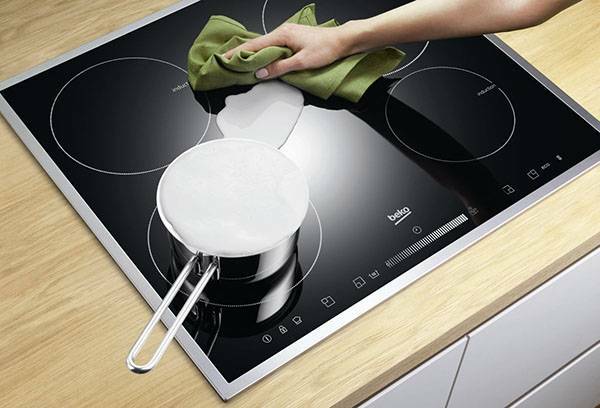
What can I use to clean the cooker?
To clean fresh contaminants, simply wipe the surface with a soft sponge and detergent, and then thoroughly wash with warm water and wipe with a cloth that absorbs moisture well. For these purposes, it is good to buy a special napkin for glass - from microfiber. If the stains still remain, you can spray a small amount of water and ammonia on the stove and wipe dry.
Such daily cleaning does not cause special difficulties, but how and how to clean the glass-ceramic plate from old pollution at home? You can use a special scraper. It can be sold complete with a stove. If not, you can buy it in the home appliances store, along with a detergent for glass ceramics.
Scraper cleaning technology is slightly different from everyday cleaning. The stove needs to be cleaned when it is still warm, or slightly warmed, so that the burnt fat softens slightly. Then, holding the scraper at an angle of 30-45 degrees, poddevat them the accumulated dirt. It is important in this case not to rush, but to remove the debris layer by layer, periodically wiping the surface with a damp cloth.
Another tool for such cases is a melamine sponge. It erases dirt, like an eraser. Before use, the sponge should be moistened with water. You can also use fine-grained abrasive sponges, such as those suitable for Teflon dishes.
Complex, highly stale soiling is best washed in a combined way.
- Remove the top layer with a scraper.
- Apply detergent.
- Clean the hob with an abrasive sponge.
- Wash the surface with a wet cloth, rinse it thoroughly, and wipe it dry.
- If there are any contaminations, wipe them with a melamine sponge.
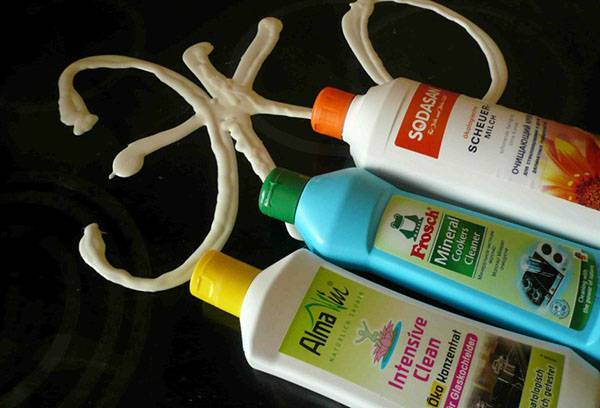
What is the most effective chemistry?
The most acceptable option is the use of cleaning agents designed for glass ceramics. In their composition, in addition to the ingredients for removing contaminants, there are substances that create a protective film on the glass-ceramic. It does not let the dirt get stuck "tightly" into the surface and facilitates the next cleaning.
Such household chemicals are produced by several companies, including manufacturers of glass-ceramic plates. As an example, you can bring Domax, Top House, Kochfeld Pflegereiniger and Selena-extra. The last means is produced by the Russian manufacturer, so the cost is much lower for the same quality with foreign counterparts.
However, not always special means cope with the removal of a strong deposit. In this case, you can conduct "resuscitation" activities - wash the plate with grease removers for enamel. Usually it is gels, less often - liquid.
According to the reviews, the following are very effective and sparing for the slab:
- Adriel;
- Fat Remover Bagi "Schumann"
- KENOLUX GRILL
It is worth remembering that grease removers are an exceptional measure, and their use can lead to discolouration of the panel, the appearance of bluish or greyish spots.
advice All household chemicals must be thoroughly rinsed off the surface to prevent long-term exposure to chemicals and sticking to chemicals.
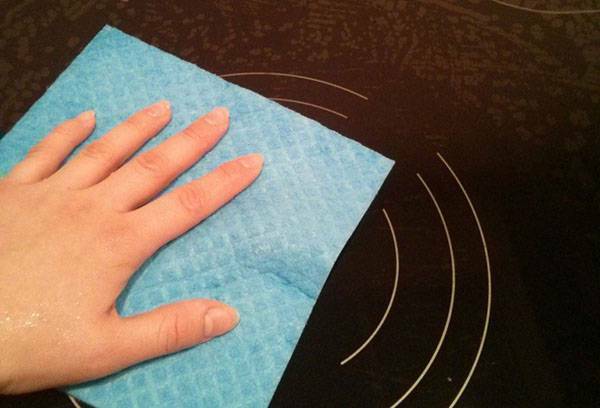
How to remove lime scale?
This problem occurs when water often gets to the surface of the panel during cooking. As a result, it evaporates, and hardness salts settle on the glass ceramics. Clean up the plaque can be two ways - folk or factory chemistry. Manufacturers of plates recommend the use of cleaning agents for glass ceramics or household chemicals for glass. The folk method is also effective and does not lead to surface damage. In addition, he will help out if you do not have household chemicals at hand, and you need to wash the plate now. How to do it?
- Dilute water with 9% table vinegar in a ratio of 1/1.The required volume is 50-100 ml.10-20 ml of ammonia can be added to the solution.
- Apply sponge or rag onto the cooled surface and leave for 10-15 minutes.
- Wipe the hob first with a damp, then dry cloth.

The most persistent pollution
The hardest thing with glass ceramics is to remove burnt syrups, jam or milk with sugar. When sugar is caramelized, it firmly adheres to the surface. Attempts to remove such carbon deposits at home often result in damage to the panel. You can often meet tips: "Do not cook jam on glass ceramics", "do not allow the syrup to hit the stove."But it's rare what a hostess will refuse to harvest for the winter, and even the most attentive "cook" jam sometimes runs away. That is why we will consider methods of combating the consequence - syrup sludge.
- If possible, a sweet liquid that has fallen on the surface should be cleaned immediately with a scraper, and after cooling the surface, wash it with a cleaning agent.
- Dark spots left after cleaning with a scraper can be removed by sprinkling them abundantly with salt and wiping after 15-30 minutes with a solution of water and vinegar.
- If it was not possible to clean the syrup immediately, you can sprinkle citric acid and pour a little water. After that, the plate needs to be slightly heated and remove the burnt sugar with a scraper.
- Frozen sugar cake can be removed with a natural remedy - apple peel. To do this, wipe it with dirty areas and leave it on top of the carbon deposit for 15 minutes, then wash the hob. If you do not get rid of everything, repeat the procedure.
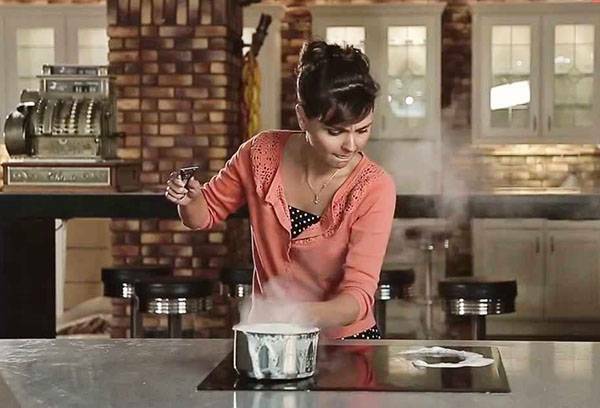
How difficult is it to look after glass ceramics?
For those who are still thinking about purchasing a glass ceramic plate, a detailed description of the cleaning process of such a surface may seem long, and care is difficult. In fact, it is not more difficult to care for such a hob than for a conventional plate covered with enamel. If you choose the right tools and detergents, then for cleaning it will take quite a bit of time and effort.

